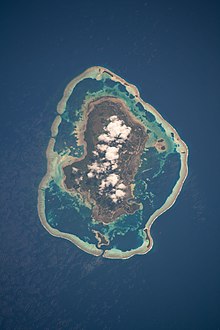Customary kingdoms of Wallis and Futuna
[2][3] The chiefdoms gradually developed independently on each island, influenced in Wallis by the Tongan invasions of the 15th century.
The Christianization of these two islands in the 1840s led to the structuring of the various chiefdoms by missionaries, freezing the borders of the Alo and Sigave kingdoms before Wallis and Futuna were brought together as a protectorate in 1888.
These scattered groups were mostly found on the island's west coast, facing the lagoon's passes.
[5] Tongans sent by their king, the Tu'i Tonga Kau'ulufonua fekai, arrived around the 15th century, and the natives scattered across the island could not resist the invasion.
[6] Tu'i Tonga Ga'asialili, the former king in charge of the conquest, subdued the Uvea kingdom and divided its territory between three chiefs: Hoko, Kalafilia, and Fakate, which later became the island's first districts.
To consolidate their already extensive domination of the island, the Tongans occupied and built numerous forts, including Kolonui, one of the most important.
They then delegated the running of the island to the Wallisians, who set up a dynastic political system based on the Tongan model.
A pyramid-type chieftaincy was set up, headed by a Hau (“king”) surrounded by advisors.
[6] Oral tradition tells of rich ties with the Samoans, whose arrival was peaceful.
However, historian Christophe Sand points out that Futuna is quite different from Samoa, having retained its own cultural and political autonomy.
[6] From the year 700, faced with Tongan expansionism in the region, the inhabitants were forced to retreat inland, building numerous forts (kolo).
The Futunians succeeded in repelling the Tongan invasions, although the latter left their mark on local culture, notably with the probable adoption of the kava as a symbol of chieftaincy power.
[11] It was from the Code of Wallis (known in Wallisian as Tohi fono), promulgated in 1871 by Queen Amelia Tokagahahau, that the royalty was structured by the missionaries.
[16] However, the code was quickly forgotten: the configuration of Wallisian royalty was perceived by the population as ancestral, even though it had previously evolved with the wars between the various clans and royal families.
[17] The royal palace of Uvea is located in the capital, Mata Utu, which is the most populous city in Wallis and Futuna, with 1,029 inhabitants.
The prime minister is called the Kalae Kivalu; this post has been held by Mikaele Halagahu since 2017.




